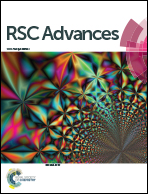Synthesis and characterization of g-C3N4 nanosheet modified polyamide nanofiltration membranes with good permeation and antifouling properties
Abstract
The incorporation of nano materials into a polyamide (PA) active layer of nanofiltration membranes has become a main choice for the improvement of membrane performance. In this paper, g-C3N4 nanosheets (CNs) were introduced to aqueous solution for the modification of a PA active layer via an interfacial polymerization reaction between piperazine and trimesoyl chloride monomers. FT-IR and XRD analysis confirmed the presence of CNs on the surface of nanofiltration membranes. SEM images indicated the formation of an active layer on the top of the polyethersulfone (PES) substrate and a good dispersion of CNs. AFM images proved that the surface roughness was increased after the incorporation of CNs. The contact angle measurement demonstrated that the surface hydrophilicity of the CN modified PA (PA/CNs) membrane was promoted. Thermal stability and surface charge of the membranes were investigated by TGA and zeta potential analysis, respectively. Compared with a pristine PA membrane, for the membrane containing CNs (0.0025 wt% in aqueous solution) a distinct increase of water flux from 20.9 L m−2 h−1 to 37.6 L m−2 h−1 at 2 bar was observed, while salt rejection of Na2SO4 was maintained above 84.0%. What's more, the anti-fouling properties of the PA/CNs membrane were investigated by using bovine serum albumin and humic acid aqueous solutions, and the results confirmed that the incorporation of CNs into PA membranes could improve antifouling performance.


 Please wait while we load your content...
Please wait while we load your content...